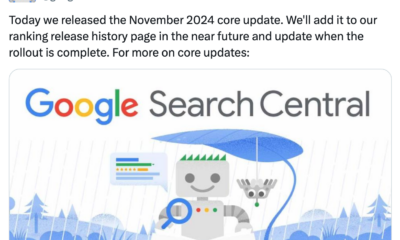MARKETING
How to Use Keywords to Combine the Power of SEO and Google Ads [Case Study]
![How to Use Keywords to Combine the Power of SEO and Google Ads [Case Study] How to Earn Topical Authority in 2022 and Beyond](https://articles.entireweb.com/wp-content/uploads/2022/06/1654724511_How-to-Earn-Topical-Authority-in-2022-and-Beyond.png)
The author’s views are entirely his or her own (excluding the unlikely event of hypnosis) and may not always reflect the views of Moz.
Spongebob and Patrick. Batman and Robin. Tom and Jerry.
These iconic dynamic duos simply wouldn’t be the same by themselves, and you can think of SEO and PPC in the same way.
You may be thinking, “But, I always thought I needed to spend my money on one or the other!”
Well, friend, I’m here to let you in on a little secret: These two, when paired together, provide you with a digital marketing double whammy. A marketing strategy based only on SEO or PPC is truly “putting your eggs in one basket”. Any business that doesn’t diversify the way they get customers isn’t realizing its full potential.
Both SEO and PPC are used for a common goal — search engine marketing (SEM) — and neither would survive without targeted keywords. Since both strategies have user intent and search demand in mind, you can:
-
Create an organic and paid strategy that surpasses your competitors and uses an optimized budget.
-
Maximize efficient content production that can be used both for SEO and PPC.
-
Expand brand SERP awareness by ranking both organic and paid.
-
Inform SEO campaign with PPC data and vice-versa (SEOs have deep insights on search intent, while Paid traffic specialists understand how keywords convert).
-
Achieve both short-term and long-term business goals.
When approached correctly, using SEO and PPC together can unlock significant opportunities for your brand, so let’s dig in!
A brief overview of SEO and PPC
Let’s take a quick look at the similarities and differences of these powerful strategies so you can better integrate both into your SEM strategies:
Main differences
Time to achieve goal
PPC provides more of a jump start, while SEO is similar to finding your life partner. SEO takes longer and is structure-based, whereas PPC is quick, focusing mainly on landing pages and click-through rates.
One important thing to mention here is that, even though PPC is faster in the beginning, it costs more in the long run. While advertising requires constant payments to sustain, SEO brings in returns long after content has been published, even if you simply just let it sit (though of course some sharing and promo always helps).
The best case scenario is to balance them both: use PPC to power up the engine, but let SEO be the fuel that consistently keeps the engine running.
Skills needed for task
You may think, “SEO is free”, and although it might be if you do it on your own, there’s still a lot of blood, sweat, and tears that go into a successful SEO strategy. SEO skills typically include:
-
Content writing
-
Ability to use a CMS
-
SEO tools know-how
-
Keyword research
-
SERP analysis
Think research, writing, design, editing, publishing, and promotion. Of course, if you hire an SEO strategist, it fast-forwards your plan because they’ve developed proven processes.
On the flip side, PPC requires skills such as:
There’s a lot more to it than that, but those cover the majority of the overarching skills.
Calculating ROI
PPC ROI can be found by observing the CTR and conversion rate in comparison with number of sales. The goal should be that you get more sales than you pay in ad spend and campaign management. With tools like Google Data Studio that integrate with your CRM, it’s possible to automate PPC ROI calculation.
SEO ROI can be found by using a similar formula:
Gain from investment – cost of investment / cost of investment.
Keep in mind, for B2B lead-based businesses, SEO ROI tends to be much more complex than e-commerce. With B2B, you need to track the organic traffic of pages purposed for lead generation, like your contact or inquiry form’s success page, because there is no direct website sale.
Similarities
As mentioned above, both strategies mainly target the SERPs. As a result, the keyword process for both should ALWAYS have user intent in mind and consider search demand.
Long-tail keywords for SEO might look like:
Meanwhile, PPC keywords are separated into four categories:
-
Phrase match – the ad is shown if there are different words before or after the keyword you’re targeting
-
Negative match – a word or words you don’t wish to target while running your ad
-
Broad match – a general phrase or word you’d like to target
-
Exact match – an exact word/phrase you’d like to target
Organic keywords for SEO are more critical inside the context of a webpage compared to PPC keywords that are more crucial inside the ad copy (though ideally, both should have the keywords in the copy that appears in the SERPs and on the page).
Ultimately, they both share a common goal: to attract relevant users to your website with the goal of turning them into customers.
How PPC and SEO work together to drive business growth through keywords
PPC can instantly unveil important keywords that can be transferred into your SEO strategy. For example, take AS Marketing’s very own client, Kindly, a B2B tech company based in Norway who sells various conversational AI tools for websites. With this project, we first focused on using organic keywords to build SEO content strategy. Then once content was published and started ranking, we regularly checked the same search terms within our Google Ads campaigns. This meant we could see the top keywords that our ads were appearing for in pretty much “real-time”, allowing us to combine this data so that we could create content that worked for both channels.
As a result of our collaboration, we achieved the following results:
-
312% organic traffic growth globally and 10X organic growth in Sweden, one of their key markets
-
5X increase in keywords ranked #1-10 in 11 months
-
107% increase in conversions
For a detailed overview of how this works, here’s our step-by-step guide to leverage this information.
Step 1: Bring the keyword data together
It’s all in the data friends. Seriously, fuse together SEO and PPC data in a spreadsheet, or even better, track ongoing efforts and data in Google Data Studio (for free!)
Here are the top metrics to jot down:
-
Search Volume: how many times a word has been searched on a monthly basis.
-
Competition: what others in your niche are ranking for.
-
Cost Per Click: how much it costs when someone clicks your link.
-
ROI: what is your average return on investment for both PPC and SEO.
-
Organic Impressions: how many times a site is viewed in a search engine result page.
-
Organic Clicks: how many people have seen your site via organic search and clicked on it.
-
Organic CTR: this term goes hand in hand with the one above. Organic click-through rate pertains to the percentage of people that have clicked on your page when they’ve seen it in the search results.
-
Organic Position: when you determine the organic position of a particular keyword, you can see which keywords are being ranked in Google’s top 100 results. This report also helps to gather useful competitor ranking data.
-
Paid CTR: paid click-through rate is the same as the organic click-through rate but for ads. It is the percentage of people that have clicked on your ad after viewing it.
-
Conversions Data: is crucial in order to improve your content and messaging. A conversion is a point at which a recipient performs a certain action. It could be filling out a form or booking a call. Conversion data is commonly tracked in Google Analytics.
When you have everything laid out in front of you, it’s easier to spot patterns and recognize how both SEO and PPC efforts are panning out.
Step 2: Do keyword research
And now for the most important part of this entire process: the stage where you find keywords that can work both for PPC and SEO.
As you go through your keyword research process to find your SEO driven keywords, make sure you utilize Google Ads ‘Search Terms’ report. This part of Google Ads allows you to see search terms that have triggered your ads, making it easy to find “real-time” keywords. It also allows you to see what search terms are trending, so if you notice the same type of keywords keep appearing, it’s probably worthwhile to dig deeper into how you can utilize these keywords into your content strategy. Here’s an example of what to keep your eyes peeled for:
![How to Use Keywords to Combine the Power of SEO and Google Ads [Case Study] Screenshot of a Google Ads dashboard with red boxes around the Keywords tab, search terms tab, and an arrow pointing to the download button.](https://articles.entireweb.com/wp-content/uploads/2022/07/1658250622_627_How-to-Use-Keywords-to-Combine-the-Power-of-SEO.png)
Throughout this process, you’ll also want to check items like:
-
Understand each keyword’s customer journey stage: How close to buying are the users? Are they in the MoFu (middle of the funnel) or the ToFu (top of the funnel) stage? Understanding the funnel stage is important, because you wouldn’t want to send someone to a sales landing page if they’re just trying to understand the basics of a new concept.
-
Gather more insights on search intent per each keyword: If PPC and SEO search intent matches, that’s a great case for a dual-purpose page! For instance, we noticed with Kindly that many users were searching for keywords related to their core product, a conversational AI chatbot. With this search intent match in mind, we used previously created SEO landing pages and also drove paid traffic to them in order to increase the amount of conversions and leads generated.
-
Understand how well your content is performing for each query: Is the content good enough for those keywords? Do you need to strengthen examples, incorporate more images, or shorten the article?
-
Create actions to improve SEO and PPC from the same keyword analysis: Which keywords have higher search demands and which have higher competition? Depending on your ad budget and authority ranking, you want to approach SEO and PPC accordingly.
-
Check SERPs for keywords that rank both organically and with paid advertising with similar content: Is it helpful to rank both paid and organically? Should you focus your resources or create content that works for both? The answer here isn’t clear-cut. It depends on your strategy, target audience, competition for the keyword, and general business goals.
Step 3: Create content with the right format
How can we get the most bang for our buck here? By creating landing pages that work for both PPC and SEO with sections like this:
-
Conversion hero header with organic- keyword-optimized H1.
-
Section blocks that cover conversion elements but also answer key audience questions. This will ensure your text is broken up, easy to read, and efficient.
-
People Also Ask ranking opportunities with a FAQ section at the bottom. Target long-tail keywords and craft valuable content to capture the audience that uses People Also Ask when searching.
![How to Use Keywords to Combine the Power of SEO and Google Ads [Case Study] Infographic with details on how to create landing pages for both PPC and SEO](https://articles.entireweb.com/wp-content/uploads/2022/07/1658250622_273_How-to-Use-Keywords-to-Combine-the-Power-of-SEO.png)
One important caveat here is that this strategy won’t work for every keyword. This is why understanding search intent and reviewing SERPs is so important, because it’ll reveal where those content opportunities are. For example, if you find that SERPs are filled with blog article results and no ads for a certain keyword, you may consider only creating the blog article.
Going back to our client Kindly, we mentioned that we regularly checked PPC search terms against our SEO keywords and ensured we understood the user intent of every keyword. It became clear that PPC was driving MoFu and BoFu keywords, meaning users were pretty much ready to buy the product. In this scenario, we knew we needed a high converting landing page that was focused singularly for the purpose of PPC.
Some examples of high converting keywords were “AI Chatbot for my website”, “AI Chatbots for Lead Generation” and “AI Chatbot for ecommerce”. From this data, we knew we needed to create a landing page that accommodated different types of use cases, so we created a landing page with a dynamic headline that catered to all keywords.
That is just one scenario, and this strategy may not work for everyone, so it’s important to understand what your customer wants and when they want it. Then you can understand when to lean into your PPC or SEO strategy and at which point of the sales funnel.
Step 4: Implement & track your strategy
For aligned SEO and PPC synergy, keep these applications in mind:
-
Identify new keyword opportunities for both channels. Use the Moz keyword explorer tool to prioritize keywords that matter, outrank your competition, and research keywords that align with your business goals.
-
Optimize SEO efforts by targeting keywords with higher conversion rates. Keywords that have high search volume AND high conversion rates are the most likely to bring in the big bucks.
-
Improve PPC efforts by aligning ads with organic search intent. For instance, say you discover a specific keyword with a high conversion rate for your PPC campaign. With this data, you can easily incorporate that keyword into your content marketing strategy to strengthen your SEO efforts.
-
Reduce costs with PPC in the middle term by targeting favorable opportunities with SEO efforts. As you continue to grow through organic search, it’ll become easier to spot what works from what doesn’t and apply that to your PPC campaigns. For instance, specific copy that resonates with your audience on your website can be repurposed for PPC ad copy.
-
Boost usage data (page acquisition and interaction etc.) with PPC to gain more data and inform SEO efforts. By increasing traffic to your site through PPC, you can further analyze your SEO strategy and understand which content types are most interesting to your audience, which pages don’t resonate, and which pages are obtaining the most conversions.
-
Last but not least, actual conversion tracking is important!Event tracking allows us to see the impact from both SEO & PPC efforts. For example with Kindly, we set up tracking not only for the number of leads, but we also tracked micro conversions such as button clicks on the navigation. By doing this, we were able to see the process of the sales funnel and which awareness, consideration and conversion keywords triggered that process. Consequently, we could determine the best URLs for each PPC campaign. With this in mind, you can also optimize your website for all marketing purposes and notice where users drop off.
-
Quickly discover high converting keywords from PPC and incorporate them into your SEO strategy
-
Create content that converts both via organic and paid channels
-
Improve brand SERP awareness (helloooo organic and paid traffic!)
-
Align and combine your short-term and long-term business goals
-
Bring the keyword data together
-
Do your keyword research
-
Create content with the right format
-
Implement and track your strategy
Merging your SEO & PPC keywords brings proven results
By taking the steps above, you can begin to merge your SEO & PPC strategies together and be more in tune with your sales funnel, i.e. generate more leads and sales. By keeping your marketing strategies as best friends, you can achieve great results such as in the images below:
SEO Results:
![How to Use Keywords to Combine the Power of SEO and Google Ads [Case Study] Screenshot of organic traffic and organic keywords over time.](https://articles.entireweb.com/wp-content/uploads/2022/07/1658250622_645_How-to-Use-Keywords-to-Combine-the-Power-of-SEO.png)
PPC Results:
![How to Use Keywords to Combine the Power of SEO and Google Ads [Case Study] Screenshot showing engagement rates, event counts, and conversion rates.](https://articles.entireweb.com/wp-content/uploads/2022/07/1658250622_244_How-to-Use-Keywords-to-Combine-the-Power-of-SEO.png)
Now, let’s crack on to the recap:
And to extend on what I mentioned previously, ‘knowledge is power’ BUT it isn’t power until put into action.
Here are your actionable steps to slingshot your business forward by combining SEO and PPC:
Teamwork makes your dream work!











You must be logged in to post a comment Login